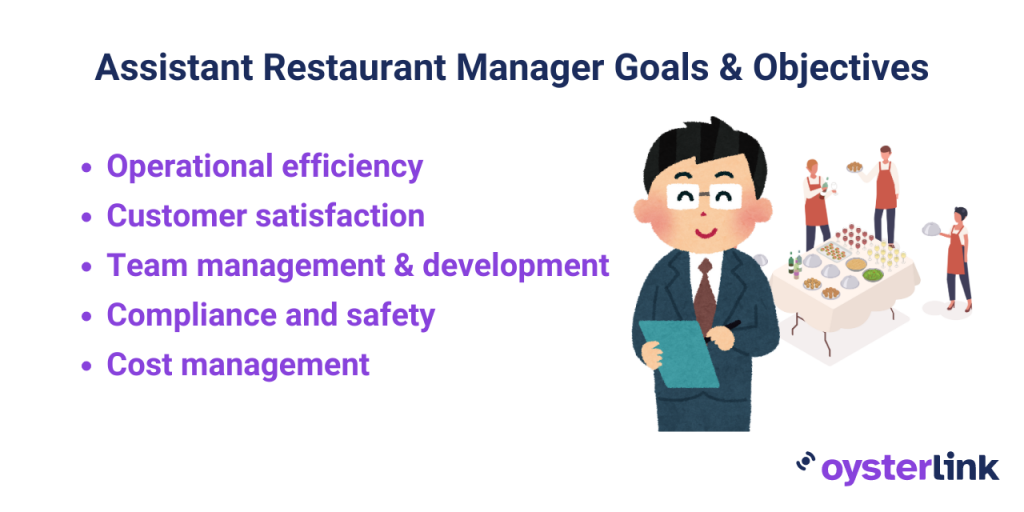While only second in command to the Restaurant Manager, the Assistant Restaurant Manager position also plays a central role in a restaurant’s success.
They’re more than just a deputy; they play the role of strategic thinker, problem-solver and motivator. Their ability to handle multiple tasks on a daily basis directly impacts the restaurant’s profitability and reputation.
Having said that, let’s dig more into this critical role. We’ve lined up our recommended Assistant Restaurant Manager Goals and objectives, plus examples to see how each contributes to the overall efficiency of the business.
Duties & Responsibilities of an Assistant Restaurant Manager
The Assistant Restaurant Manager is a junior management role that bridges the gap between frontline staff (such as Servers, Cooks and Bartenders) and the Restaurant Manager or General Manager.
Reporting directly to the Restaurant Manager, they supervise most staff and assist in the restaurant’s day-to-day management. Their key duties and responsibilities include:
- Overseeing daily operations, including opening and closing the restaurant
- Recruiting, training and mentoring front-of-house (FOH) staff
- Creating and managing schedules for FOH employees
- Handling payroll, tracking income and expenses and balancing cash registers
- Enforcing health and safety regulations
- Resolving customer issues and ensuring guest satisfaction
- Managing inventory levels, placing orders and finding suppliers
See the Assistant Restaurant Manager‘s full job description to learn more about this position.
Top 5 Goals and Objectives of Every Assistant Restaurant Manager
It’s not just a checklist of chores they must complete every day; every task performed by the Assistant Restaurant Manager should contribute to a bigger objective.
Remember that when setting the goals, they should determine the focus area, provide clear and measurable targets and have a defined timeframe.

We’ve identified the top five key areas of focus, plus specific Assistant Restaurant Manager goals and objectives examples for each.
1. Operational efficiency
Streamlining processes, maximizing productivity and reducing costs without compromising quality are important to achieve operational efficiency.
While these strategic initiatives often come from the upper management level, it’s the Assistant Restaurant Manager’s job to oversee their successful implementation. This role is critical in optimizing staffing levels, managing inventory and supplies and maximizing equipment utilization.
To illustrate these operational efficiency goals, consider the following examples:
| Goal | Objective | |
| Example 1 | Reduce food waste by 20% within three months for better cost control. | Implement a standardized portion control system and donate excess food to local shelters. |
| Example 2 | Decrease average table turnover time from 45 minutes to 35 minutes within two months. | Implement a more efficient order-taking process and optimize kitchen workflow. |
2. Customer satisfaction
Building a loyal customer base and attracting more clients is every restaurant business’ goal.
To achieve this, Assistant Restaurant Managers must cultivate a culture of exceptional service by inspiring their team to consistently deliver outstanding dining experiences. Effective issue resolution is important, but it’s equally vital to conduct thorough post-incident reviews to identify root causes and prevent a repeat of the incident.
Consider these examples of setting specific goals focusing on customer satisfaction:
| Goal | Objective | |
| Example 1 | Increase customer satisfaction scores from 85% to 90% within six months. | Develop a feedback system to ensure customer satisfaction and address customer complaints promptly. |
| Example 2 | Increase the number of repeat customers by 15% within six months. | Launch a loyalty program and personalized customer recognition initiatives. |
3. Team management and development
Another primary goal for Assistant Restaurant Managers is to promote a positive work environment and foster teamwork. This requires collaborating with the Restaurant Manager to identify staff training needs and develop career growth plans.
Remember that it can cost more to hire new employees than to train current ones.
Moreover, finding the right people for every position and managing their performance are the ingredients to building a high-performing team.
Here are a couple of examples on how to do goal setting and creating programs to enhance team management and development:
| Goal | Objective | |
| Example 1 | Enhance employee engagement and retention through effective team management and development. | Implement a mentorship program within six months to pair experienced employees with new hires, resulting in a 15% reduction in employee turnover rate. |
| Example 2 | Improve employee morale by getting a 10% increase in overall employee satisfaction scores within a year. | Conduct quarterly employee satisfaction surveys and implement at least one improvement based on feedback within two months of each survey. |
4. Compliance and safety
Assistant Restaurant Managers are also responsible for ensuring strict adherence to food safety, health, and labor regulations. Creating a safe workplace for employees and serving safe food to customers should be a top priority.
The Restaurant Manager may be the one responsible for establishing food safety protocols, but the Assistant Restaurant Managers would handle implementation and monitoring.
Our example below shows a clear outline of how to achieve a goal on restaurant compliance and safety.
| Goal | Objective | |
| Example 1 | Reduce workplace accidents by 20% through enhanced safety training and hazard identification. | Maintain a safe and compliant restaurant environment to protect employees and customers. Conduct regular safety audits to identify and address potential hazards. |
| Example 2 | Achieve and maintain a perfect score on all health inspections. Ensure 100% compliance with all local, state, and federal labor laws. | Maintain up-to-date certifications for food safety, fire safety, and other required licenses in the restaurant industry. |
5. Cost management
The primary goal of cost management in restaurant operations is to maximize revenue growth by minimizing expenses without compromising the quality of food or service.
This involves:
- Identifying and reducing unnecessary costs
- Optimizing the relationship between revenue and expenses
- Ensuring financial stability and growth
- Protecting profit margins
Again, while the Assistant Restaurant Manager position may not develop cost-cutting strategies, they’re responsible for closely monitoring expenses. Here are specific examples of goals related to cost management.
| Goal | Objective | |
| Example 1 | Reduce labor costs by 10%. | Optimize scheduling and increase employee productivity within the next quarter. |
| Example 2 | Reduce food cost percentage from 32% to 28% within six months. | Implement stricter inventory control, minimizing food waste and negotiating better prices with suppliers. |
What Makes a Good Assistant Restaurant Manager?
A successful Assistant Restaurant Manager is a results-oriented leader capable of accomplishing both operational efficiency and guest satisfaction. They should have a blend of the following qualities:
- Leadership: The Assistant Restaurant Manager must have the ability to inspire and motivate staff; they can delegate tasks efficiently, provide clear guidance and make sound decisions under pressure.
- Industry experience: Experienced Assistant Restaurant Manager have a deep understanding of restaurant operations, which allows for swift problem solving, cost management and menu development.
- Detail-oriented: Precision is one of the key Assistant Restaurant Manager skills. Therefore, meticulous attention to detail is an important quality to have.
- Problem-solver: Working in a fast-paced environment like a restaurant requires the ability to think critically and quickly find solutions to any issues. This is especially critical in providing seamless customer service.
- Excellent communicator: Open and effective communication is crucial for interacting with staff, customers and management. The Assistant Restaurant Manager must be able to convey information clearly, listen actively and resolve conflicts diplomatically.
Conclusion
Assistant Restaurant Managers help ensure a smooth-running restaurant operation, making sure that every aspect — from the kitchen to the dining room — functions efficiently and harmoniously.
They must set clear goals and targets to ensure alignment with overall business objectives. Also, by defining their responsibilities and desired outcomes, Assistant Restaurant Managers can maximize their contribution and impact to the restaurant’s success.




